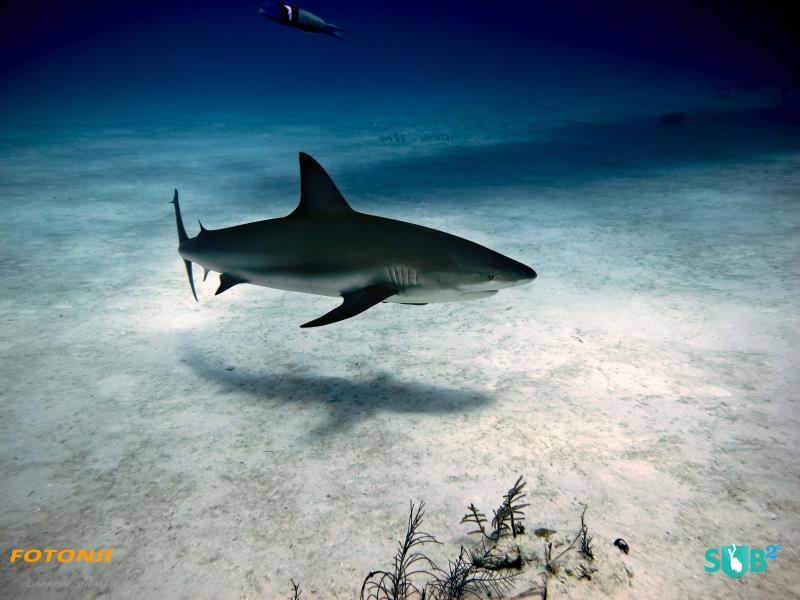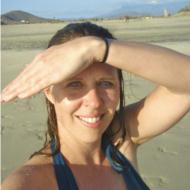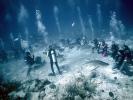 Advice on Scuba Diving in Southeast Islands Exuma, The Bahamas
Advice on Scuba Diving in Southeast Islands Exuma, The Bahamas
Part 1: Overview of Scuba Diving in Southeast Islands Exuma, (The Bahamas)
The southeastern half of the Bahamas is made up of smaller islands and cays than the northeastern realm near Nassau. About 50 miles east of Nassau is the long thin island of Eluethera. The island offers amazing scuba diving along its 110-mile length. Many sections of the island are less than a mile wide. The word Eluethera is Greek for “free” and that was the intention of its puritan pilgrims who settled the island and named it back in 1648.
Eleuthera offers large outcrops of ancient reef along its unusually pink sandy beaches. The island is also famous for its pineapples. The eastern edge of the island faces the Atlantic Ocean and the western curve of the island of Eleuthera faces the Great Bahama Bank. This huge expanse of shallow water lies over a submerged, ancient coral platform. Offshore its western shore, Eleuthera offers some of the best scuba diving on the Bahama Bank. Much of the water over the expanse of the Great Bahama Bank is no deeper than 25 meters and in many places much shallower. During the recent glaciation period, much of the bank was exposed to the air, as the seawater was locked frozen around the Earth's poles. The limestone that makes up the Bahama Bank was then exposed to rain water (naturally slightly acidic) and dissolution and erosion created the many caves and sink holes that are now the caverns and blue holes, offering world class scuba diving today. The vast shallow bank of the Bahama area gives so much area to explore and surface area for coral to grow and thrive. The photic zone is exposed for miles and miles in the shallows of the Bahamas. Dunmore Town is on the northern shore of Eluethera and Freetown to the south (not to be confused with Freeport on Grand Bahama Island).
South of the Nassau area is Cat Island, where scuba divers will find the town of New Bight and New Bight Bay. Cat Island has the highest elevation point in the Bahamas, at just 206 feet. Close to Cat Island, towards the Atlantic, is the small but famous San Salvador Island, where Columbus reportedly first made landfall in the Americas in 1492. On Cat Island, there is the Columbus World Centre Museum, where the history of the Bahamas and the discovery of the Americas are highlighted.
South of Cat Island is Long Island, a popular beach and scuba destination. The Atlantic shores of Long Island are rocky and rough, and its southwestern coast offers some of the most scenic white sand beaches in the Bahamas. Long Island also offers amazing dive sites along the expansive reef bank that extends out into its clear, blue shallows.
Exuma is a district of the Bahamas that is made up of a long extending chain of islands in central Bahama. There are over 360 cays that make up Exuma. The largest island is called Great Exuma, where its capital Georgetown resides. The local Indians of the Bahamas made their home on Exuma long before the pilgrims settled and disrupted the subtropical flow of life in the Bahamas.
The islands that make up the Exumas are popular for yachting, sailing, and scuba diving on Exuma's many coral reefs, caves, and blue holes. Many of the unnamed beaches and coves of the Exuma islands and its offshore reefs are protected as part of Exuma National Land and Sea Park of the Bahamas National Trust.
Working south is the remote island of Mayaguana, the easternmost island of the Bahamas. The deep waters of the Atlantic Ocean border Mayaguana from the east. Mayaguana offers extensive offshore coral reefs and shipwrecks for scuba divers to explore. Sea turtles commonly nest along the undeveloped eastern shores of the island. Mayaguana is one of the least visited islands in the Bahamas. Most tourists who make their way to Mayaguana do so to experience the isolation, as well as the amazing scuba and snorkeling diving sites, bone fishing opportunities, and duck hunting. The eastern part of Mayaguana is also popular with mountain bikers. The island of Mayaguana also serves the Ecotourism.
Making towards the southern extent of The Bahamas are the Acklins, a group of islands that form a moon shape around a large, shallow lagoon called the Bight of Acklins. The curved string of islands is made up of the larger island of Crooked Island in the north and Acklins Island to the south. The lagoon and its shallow reef offer an ideal sheltered sanctuary for scuba divers to explore the beauty of the reef and its wildlife.
The southern most islands of the Bahamas are the Great Inagua and Little Inagua. The southern part of Great Inagua is only about 40 miles from Cuba and only 30 miles from Turks and Caicos Islands.
Part 2: Dive Sites, Marine Life & Environment in Southeast Islands Exuma, (The Bahamas)
The islands that make up Exuma are where a vast majority of the natives of the Bahamas resided before Columbus ever sailed the ocean blue, and long before that period in human history. The Bahamas are an ancient coral reef bank that has sunk under its own weight. It is reported that some 4,000 plus feet of ancient reef lies beneath the modern living reefs that we enjoy diving today. The Bahama Bank offers world class diving and the Exuma Islands are a classic place to explore some of the best scuba diving that the Bahamas has to offer. The Exuma cays extend over 100 miles, running in a nearly straight line northwest to southeast.
There are many established dive sites off the northern Exuma Cays. It’s worth hiring a liveaboard and really exploring this amazing central Bahama location. The Exuma islands have been the filming sites for two James Bond movies – Thunderball and Never Say Never Again. Great Exuma to the south is the largest island, making up the Exuma chain, but many amazing dive sites are in the northern realm of the Exumas along the many small cays. Off Norman's Cay, there is the dive site called Cracked Coral Head, a great dive site remote from any signs of civilization and abundant in coral and marine life. You will likely dive with stingrays, hammerhead sharks, brilliant French angelfish, dolphins, and - if you are lucky- abundant lionfish. Just north of Norman's Cay is Exuma Cay Land & Sea Park, a reserve protecting the amazing reef and its marine inhabitants. Just to the north of the Norman Cay area you get to Highbourne Cay, where you can dive sites named Herman's Reef and Highborne Cay Wall. The list of established dive sites and yet unclassified dive sites in the Exumas is endless.
Moving east to the Bahama border with the Atlantic Ocean is the famous island of San Salvador, where Columbus reportedly first landed. There are amazing dive sites to explore on the calm lee side of San Salvador, where the water is typically visible as far as 150 feet! Offshore from the town of Cockburn is the Cockburn Town Wall. Starting just 40 feet underwater, the wall is an amazing scuba diving site to explore. Just off the northeastern shore of San Salvador is Green Cay, a small island whose reef grounded the Brig Enterprise Wreck back in 1832. Another wreck dive in San Salvador worth diving is the Frasgate Wreck out in Bonefish Bay in 1902.
There are countless islands, islets, lagoons, blue holes, walls and small cays to explore in the vast territory of the Bahamas. The warm waters and high visibility make it ideal for underwater exploration. There are hundreds of established dive sites through the southern zone of the Bahamas but thousands that have yet to be swam and explored.
Part 3: Dive Shops, Airports & Logistics of Diving in Southeast Islands Exuma, (The Bahamas)
Looking to scuba dive off Exuma, Eleuthera or San Salvador? Even the small, less visited southeastern Bahama Islands have airstrips for quick hop flights. When arriving into the Bahamas, most scuba divers begin in Nassau, flying into the high traffic Lynden Pindling International Airport (NAS). Another common starting point is to fly into Grand Bahama International Airport (FPO) on the northern island of Grand Bahama. From these two international destinations, there are many domestic flights that can be booked last minute at reasonable costs that will deliver south, away from the high tourist locations up north.
To get to the island chain of Exuma, fly into Exuma International Airport (GGT) then hop flight or boat to the smaller islands that offer amazing scuba diving, north of Exuma's main island. To get to the island of Eluethera, book a flight from Nassau to Rock Sound International Airport (RSD). There are many private airstrips on many of the Bahamas southeastern islands. Even the remote, southern island of Mayaguana has an airport by the same name. If you want to fly into where Columbus first landed after sailing the ocean blue in 1492, fly into San Salvador Airport.
On the long island chain of Exuma is the central area of the Bahamas, where there are resorts and dive shops that offer amazing day trips for scuba divers. On the main island of Grand Exuma, there is the town of Georgetown; check out the availability of the dive shop called Dive Exuma found at the Exuma Yacht Club. Dive Exuma offers snorkel trips and scuba trips to the many blue holes off the extensive Exuma cays. In Georgetown, there is also Exuma Dive Center, a great smaller dive shop that offers customized day trips for scuba divers looking to explore the Exuma cays.
A full service option for scuba divers is the resort and dive shop on beautiful Cat Island, Dive Cat Island dive shop. This scuba centric location is part of Hawk's Nest Resort. On the island of Eleuthera, stay at Ocean Fox Cotton Bay resort and have easy access to amazing dive locations and the services of the resort's dive shop in Eluethera's Davis Harbour. On the northern tip of Eluethera are Harbour Island and the scuba outfitter Valentine's Dive Center. This scuba center offers amazing day trips to great local dive sites along Eluethera's northern realm, and extensive scuba classes for beginners and advanced divers looking to expand their certification.
A great historic location to settle for a long relaxing week and get some amazing dives logged is San Salvador, the island where Columbus first set foot in the Americas. San Salvador's eastern shore makes up the Bahamas Atlantic Ocean boundary. Stay at Riding Rock Resort and Marina to explore the history and to arrange local scuba diving expeditions right from the comfort of your own resort.
---- Book Your Diving ----
Fill in the Form Below.
Our hand picked regional partners will deliver no obligation quotes.

Tweets by @DiveAdvisorApp



